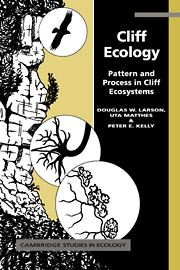2 - Geology and geomorphology
Published online by Cambridge University Press: 16 September 2009
Summary
In most discussions of terrestrial ecology, the weathering patterns and age of the bedrock are an important part of the ecological context. This is especially true on cliffs where soil formation is either absent or minimal and there is direct contact between the rock face and the biota at all times. On level ground, the underlying geology becomes less critical and the processes of soil formation more critical to plant and animal communities over time (Oettli, 1904). The persistence of the contact between the biota and the rocks on cliffs (most often without soil) makes it necessary for us to present a broad summary of the important geological and geomorphological characteristics of cliffs which may influence the abundance and distribution of the biota on the surface.
Bedrock composition and strength
The emergence of cliffs in the landscape is dependent on both the mechanical strength and the variability in the strength of the bedrock. These traits are built into the rock, both during the initial deposition of the materials and in the subsequent reshaping of the strata by crustal plate movement and large-scale geomorphological events such as glacial advances or the outflows from rivers. The variability built into different strata results in differences in the physical expression of weathering processes, with the removal of weaker materials and the retention of stronger ones. The pronounced series of cliffs interrupted by talus slopes lining the walls of the Grand Canyon, USA, is caused in part by this vertical mgeological heterogeneity in wear resistance (see Fig. 1.2).
- Type
- Chapter
- Information
- Cliff EcologyPattern and Process in Cliff Ecosystems, pp. 19 - 42Publisher: Cambridge University PressPrint publication year: 2000

